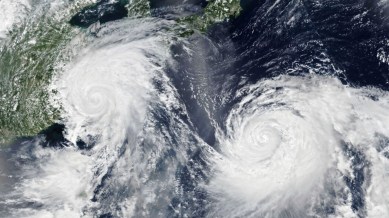Stay updated with the latest - Click here to follow us on Instagram
La Nina and warm ocean to cause ‘above-normal’ hurricanes over Atlantic Ocean this year: NOAA
At present, El Niño conditions that have been persisting since December are weakening, and NOAA expects neutral ENSO conditions to emerge soon.

The National Oceanic and Atmospheric Administration (NOAA) has warned of ‘above-normal’ hurricane activity between June and November this year. “There is an 85% chance of an above-normal hurricane season,” NOAA officials said.
This forecast comes as the La Niña climate pattern, which typically leads to increased hurricane activity in the Atlantic, is expected to emerge later this year. Additionally, NOAA cited warmer-than-average sea surface temperatures in the Atlantic Ocean as a contributing factor.
monthly limit of free stories.
with an Express account.
“ENSO [the El Niño-Southern Oscillation] has a huge impact on hurricane activity over the Atlantic Ocean. Generally, El Niño reduces hurricane activity, while La Niña tends to increase it,” M Rajeevan, former secretary of India’s Ministry of Earth Sciences, told The Indian Express.
During the 2021 La Niña, the Atlantic Ocean experienced a record-breaking 30 storms. At present, El Niño conditions that have been persisting since December are weakening, and NOAA expects neutral ENSO conditions to emerge soon. However, the warm Atlantic Ocean could still provide fuel for an active hurricane season.
This comes ahead of the onset of the La Nina conditions over the central and equatorial Pacific Ocean, which is expected later this year. Multiple global weather models, including India’s, have suggested that cooler-than-average sea surface temperatures – indicating La Nina conditions – are likely to emerge by August this year. “Besides, reduced trade winds and lesser wind shear in the tropics also contribute to the development of storms,” NOAA said.
The African easterly waves produced during the hurricane season could allow storms to stay longer in the Atlantic Ocean, intensify, and result in strong, long-lived storms, NOAA added. The weak trade winds associated with La Niña could also contribute to storm intensification by limiting upwelling.
On Thursday, NOAA released the list of hurricane names for the 2023 season, including Oscar, Rafael, Patty, Isaac, Helene, and William, among others.
La Nina and El Nino
Converse to La Niña is El Niño, wherein warmer-than-average sea surface temperatures are recorded over the equatorial Pacific Ocean. El Niño and La Niña represent the warmer and cooler phases, respectively, of the naturally occurring El Niño-Southern Oscillation (ENSO) phenomenon, which also has a neutral phase.
Oceanic storms are powered by heat that act as a fuel and regulate their intensity. After the unfolding of La Nina, a warm Atlantic Ocean could contribute towards heightened hurricane activity this year, the NOAA said. With record warm temperatures recorded over the Atlantic Ocean, the storms will obtain more energy for their development and intensification.